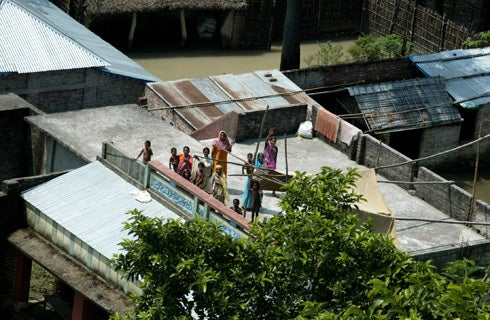Troops and aid workers are scrambling to reach hundreds of thousands of stranded people across flood-devastated northern India in one of the country's largest-ever relief efforts, as hungry villagers began to riot, desperate families swam for their lives and widespread chaos ruled.
Nearly half of the 1.2 million people left homeless when the Kosi River burst its banks in Nepal two weeks ago, spilling over north India's vast plains, had been rescued said Prataya Amrit, a top disaster management official in Bihar state. Despite disjointed efforts, officials hoped to reach the rest in the next two days.
The massive relief effort was the first to deploy all three branches of India's military — the army, the navy, and the air force, Amrit said.
Even as more than 5,000 troops fanned out across the state to rescue marooned communities and provide much-needed food and medicine, new areas flooded and cut off still more villages.
The road linking Saharia village to the rest of the hard-hit Saharsa district washed away Monday. Villagers waded through neck-deep waters carrying bicycles above their heads and bags of clothes on their shoulders.
"The water came on Saturday and since then no government officials have come to us," said Ram Bachan Rai, 60.
Rajendra Sah, 43, was one of many to complain that authorities were not distributing aid equally. "Influential people are taking all the relief materials," he said.
There were also scattered reports of looting across the region. "People came in a boat and took away the grain we had stored on the roof," said Chetu Yadav, a Saharia resident. "They were armed so we were afraid to challenge them."
Nearby, aid workers from UNICEF and the European Union tried to work out how best to provide help. "We are going from place to place trying to assess the needs of the people, see what gaps there are and how we can fill it," Malini Morzaria of the European Commission's Humanitarian Aid department said as she waded through knee-deep water.
The government has set up relief centers in schools across the region, and thousands of people crowded into the buildings for hot meals of rice and lentils. Many also brought along their cattle and goats.
With the numbers in the camps expected to nearly double in the coming days, there were fears the crowded and often-unsanitary conditions could lead to outbreaks of diseases such as cholera.
The United Nations warned "the heat, combined with limited supplies of safe drinking water and poor hygiene conditions, poses a great risk of water- and vector-borne diseases."
The relief was disjointed, and many areas saw displaced people camped out on whatever high ground they could find — embankments, railway tracks, bridges.
In Madhepura, one of the biggest flooded towns, residents stormed a government office late last night throwing stones and demanding food, television news reports showed.
Officials say the flooding is expected to continue until November when the last of the monsoon rains taper off. Only then will they be able to plug the breach in the Kosi River that is more than a mile wide and growing.
The river, which flows down from the Himalayas into India where it joins the Ganges River, dramatically changed course after the breach, moving dozens of miles to the east and turning hundreds of square miles of land into a virtual lake.
Officials don't yet have a precise tally of those killed, but estimates range from scores to thousands. On Friday, 19 people drowned when their rescue boat capsized.
While Bihar, one of India's poorest states, is used to flooding from the annual monsoon, this year's floods have been particularly devastating because they have hit areas that normally remain dry and lack the infrastructure to deal with the rising waters.
Meanwhile in the northeastern state of Assam, monsoon floods submerged roughly 1,500 villages, drowning 15 people and displacing hundreds of thousands, said the state's Relief and Rehabilitation Minister Bhumidhar Barman. State authorities were working hard to reach affected areas, Barman said.
Two of Assam's major rivers, the Brahmaputra and the Barak, are flowing above the danger levels at more than a dozen places in different parts of the state, according to a bulletin issued by the Central Water Commission, a federal flood monitoring agency.
The monsoon season, which starts in June, brings rain vital for the farmers of South Asia but also can cause massive destruction.
In neighboring Bangladesh, flooding has cut off at least 50,000 people as a flood warning agency forecast the situation was "likely to deteriorate." News reports said three people drowned yesterday in flood-ravaged areas north of the capital of Dhaka.

Join our commenting forum
Join thought-provoking conversations, follow other Independent readers and see their replies
Comments